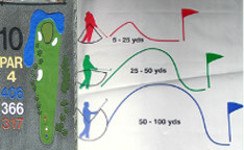
Professional golfers now hit the ball so far, we're seeing holes of up to 520 yards designated as par 4s.
The distance is not a big deal for pros, all of whom can cover that length in two shots. But it does change their expectations for the hole, which can affect how they play it – and that's a trap amateurs must be careful to avoid.
Let's say you're playing a hole with a distance at the limit of your two best shots; let's call it 450 yards. Would you approach it differently if the hole were a par 4 rather than a par 5? You shouldn't. Unless you're a low-handicapper, chances of making 4 on such a hole are slim. But a 5 may be well within your grasp if you simply play conservatively.

First of all, forget about making the green in regulation (two shots for a par 4) and play it as a three-shot hole. If the tee shot is fraught with peril, hit a fairway wood or hybrid to be on the safe side; it won't matter if you're too far back to reach with your second shot. If there's trouble in front of the green, lay up short and pitch on. Getting too aggressive in pursuit of a par greatly increases your chances of making double-bogey or worse. Conversely, if you think of it as a three-shot hole, you could find yourself with a makeable par putt.
Determine how far your best drive and longest fairway wood will travel – for example, 450 yards. Play any hole in that range or longer as a par 5, no matter what the scorecard says.
You'll eliminate those dreaded big numbers, and make a surprising number of pars in the process.
The entire game of golf is built around the concept of par.

On each hole, you are sure to check the scorecard to determine what par is for that hole before you hit your tee shot. Or, you may even take a look at the scorecard before your round begins, to learn how many par threes, fours, and fives you will encounter. A standard-length golf course usually features a par of between 70 and 72 for 18 holes. Often, players will state their score not as an actual number, but rather in comparison to par. For instance, a golfer may report his or her score as 10-over-par, rather than as an 82. No matter where you look in this game, the concept of par cannot be escaped.
In this article, we are going to present a rather surprising and unusual concept. We are going to make the argument that you should actually pay no attention whatsoever to par. Rather than being a central part of the game, we think that you should see it as irrelevant to what you are trying to do on the course. It will take some time to break the old habits you have built of relying on par to guide your decision making, but you'll soon come to see the error of your previous ways. Once you manage to let go of par, you may find that your scores quickly begin to move in the right direction.
Do you think par matters in professional golf tournaments? Most likely, your answer to that question would be a definitive 'yes'. After all, when you see the leaderboard on TV, the scores are always listed in relation to par. A given golfer may be leading the tournament on the last day with a score of 12-under-par, while the second-place player is a couple strokes back at 10-under. So, par is a critical concept in pro golf, right? Not at all. In fact, par is completely irrelevant to the outcome of any golf tournament.
At the end of the tournament – usually three or four 18-hole rounds at the top of the pro game – the player with the lowest score wins. It doesn't matter what par had been listed on the scorecard throughout the tournament. The only thing that matters is which player managed to complete the tournament while using the fewest number of strokes.
All along, par has been an imaginary enemy. It isn't really there, but yet many golfers obsess over it as they play. Not only do we think that you can improve your game by ignoring the concept of par, we also think you'll have more fun. You will start to see the golf course in new ways, and your creativity may move to a new level. If you are willing to keep an open mind, this idea could change your future on the links.
All of the content below is based on a right-handed golfer. If you happen to play left-handed, please take a moment to reverse the directions as necessary.
From Tee to Green

As a golfer, your job is to move the ball from the tee to the green – and into the hole – in as few strokes as possible. That is the entirety of the game. Sure, there are some rules to follow along the way, but the game is about starting on the tee box and ending in the hole. One of the great things about this game is the flexibility that you are afforded to get the job done. You are free to approach the hole in whatever way you see as the best option, as long as you don't break any rules. When golf is played properly, there is a lot of creativity involved. Unfortunately, the mental constraints created by the concept of par often rob golfers of their creative juices.
Let's walk through an example to illustrate this point. Imagine for a moment that you are playing a long par four with a large pond guarding the front of the green. The hole is well over 400-yards long, and in addition to being guarded by water, the green is also quite small. By anyone's definition, this is a difficult hole. Most golfers would be thrilled to finish this type of hole in four strokes, and even using five would not be the end of the world.
On the tee, you decide to use your driver because of the length of the hole. Fortunately, you send the ball right down the middle, although you don't quite hit the drive as far as you would like. Nonetheless, you are positioned nicely in the center of the fairway. When you arrive at the ball, you find that you still have 210-yards left to reach the green. And, of course, you'll need to carry the ball over that pond in front of the putting surface if you are to wind up with a successful shot. Unless you are a powerful player who can hit an iron shot to cover this distance, you are facing a daunting proposition. You'll need to strike a perfect shot with one of your longest clubs in order to keep the ball dry, and you have very little chance of actually placing the ball on the green.
If you were to take par out of the equation, the right shot for the situation at hand would be obvious – you would lay up. A layup would take the water out of play, and you would be able to position yourself for a simple pitch onto the green. You could still finish the hole in four strokes if you get up and down after the layup, and it would be a pretty safe bet that you will do no worse than five. Laying up greatly reduces the likelihood of making a big mistake, so you can keep your round on track and hope to take advantage of easier holes.
But are you going to lay up? If you are like most golfers, the answer is no. Since this is a par four, you are going to go for the green with your second shot. Most amateur golfers – almost regardless of circumstances - will go for the green simply because the scorecard says that par is four. This type of 'strategy' doesn't make much sense, but it is still common practice. In trying to force the ball up to the green in two shots, the player is likely to make a costly mistake, and their score will climb much higher than it would have otherwise. Laying the ball up is a pretty obvious choice, as long as you can put the pressure of par out of your mind.
The lesson here is simple – when standing on the tee of any golf hole, you should be thinking only of completing that hole in the fewest number of strokes possible, given the constraints of your game. Every player is limited to some degree in terms of distance and the ball flights they can produce, and it is foolish to attempt shots which lie outside of those constraints. Forget about par, make decisions based on your capabilities, and watch your game improve almost immediately.
Pressured into Bad Decisions

In the previous section, we talked about how paying too much attention to the par of a given hole can get you into trouble on the course. In our example, we showed how you could be pressured into making a bad decision just because you are trying to reach the green in two shots on a long par four. This is but one example of how par can cause you to do silly things. In the list below, we have highlighted some additional examples for you to consider.
- Going for the green on a long par three. The idea here is the same as the example we presented in the previous section, except we are talking about a par three instead of a par four. For most golfers, it is automatic to go for the green with the tee shot on a par three. After all, isn't that what you are supposed to do? Usually, yes, you will go for the green with your first shot on a par three. But you don't have to. If the shot is simply outside of your capability, laying it up to a safe spot where you can chip onto the green is a good option. You still may make a par anyway, and you should have little trouble making a bogey. A bogey might not be ideal, but it isn't a bad result when you consider the length of the hole and the hazards which may have been in play off the tee. Think about it this way – how often do you make a three on long par threes anyway? Probably not very often, as these are some of the most difficult holes in golf. So, even if you make a four, there really isn't anything lost. And, if your short game provides you with a boost, you could walk away with a three.
- Forcing the action on a par five. Playing a par five brings a different kind of pressure than something like a long par three or four. On a par five, you will feel pressure to make a good score, since these are usually the easiest holes on the course. If you are normally a bogey golfer, you will think of par fives as your best chance to record some pars. For a better player, par fives are birdie chances. Either way, your decision making may be negatively influenced by the fact that you expect to write a good score down on your card on these holes. There is nothing wrong with trying to post a good score on the par fives, of course, but you shouldn't feel pressure to play more aggressively than normal. The right shot for the situation is the one that gives you the best chance of success, regardless of par. One common mistake on par fives is feeling the need to go for the green in two shots. That will work on some occasions, but it can also backfire if you attempt it on a shot that really isn't a good opportunity. By forcing the issue, you can get into trouble, turning an easy hole into a tough one.
- Attempting to drive a short par four. Golf course designers love to use short par fours. Without a doubt, these can be some of the most exciting holes on any given course. The idea is simple – the course designer is trying to tempt you into trying an aggressive shot, even if that shot is not the smartest option for the situation at hand. A short par four will often have a distance of somewhere between 280 and 300 yards, and there will usually be some kind of hazard up around the green. Amateur golfers will frequently go for the green off the tee on these holes, even if they don't actually have the power to reach the putting surface. The results are predictable – the ball ends up in a tough spot most of the time, even if the player makes a good swing. Unless you can actually drive the ball far enough to reach the green, and high enough to make it stop, a layup from the tee is probably the better play.
Playing to par can get you into all sorts of trouble. We aren't trying to say that you should always layup with every shot you hit on the course, because that would make for a boring game. Sometimes, going for the green is warranted, but that decision has nothing to do with the par listed on the card. Rather, it is related to the design of the course and your own abilities. If a particular long shot doesn't present much risk, or if it is a perfect fit for your ball flight and you have a great lie, then feel free to go for it. But don't go for it just because the score card says you need to reach the green on this shot in order to two putt for your par. Restricting yourself to making decisions based on par is bound to lead to poor choices.






